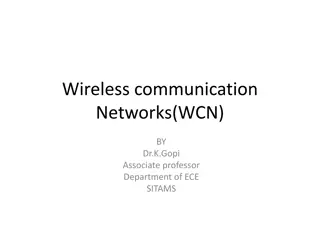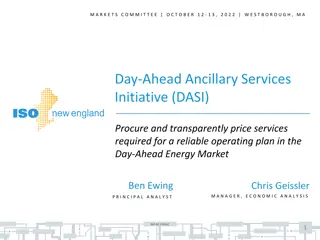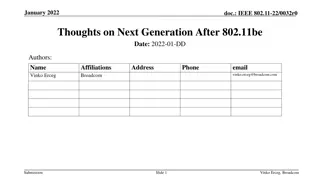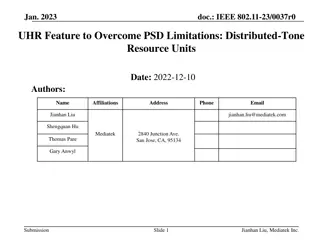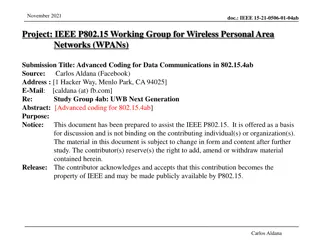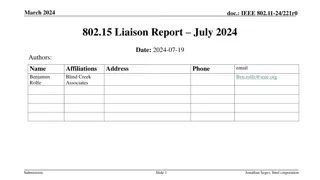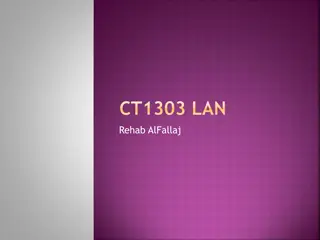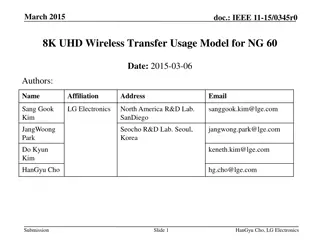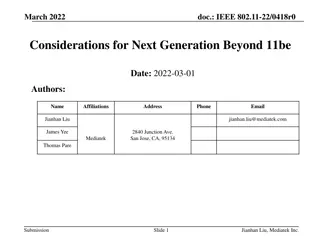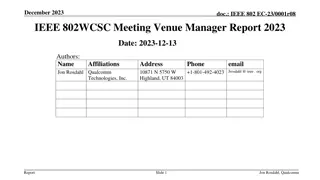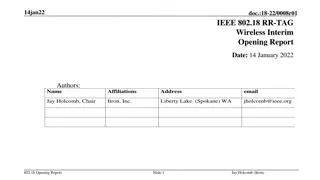IEEE 802.11-22/0030-01-00be: Look Ahead to Next Generation Wireless Communication
Encouraging the development of a new PHY/MAC amendment to IEEE 802.11 for enhanced Wi-Fi capabilities, targeting higher throughput, low latency, full coverage, and machine learning support. The presentation emphasizes the need for advancements to meet increasing data rate requirements for applications like VR, wireless projection, and XR communications.
Download Presentation

Please find below an Image/Link to download the presentation.
The content on the website is provided AS IS for your information and personal use only. It may not be sold, licensed, or shared on other websites without obtaining consent from the author. Download presentation by click this link. If you encounter any issues during the download, it is possible that the publisher has removed the file from their server.
E N D
Presentation Transcript
Jan 2022 doc.: IEEE 802.11-22/0030-01-00be Look ahead to next generation Date: 2022-01-10 Authors: Name Affiliations Address Phone email Ming Gan ming.gan@huawei.com David Xun Yang Edward Au Osama AboulMagd Michael Montemurro Stephen McCann Huawei Technologies, Co. LTD. Submission Slide 1 Ming Gan, Huawei
Jan 2022 doc.: IEEE 802.11-22/0030-01-00be Abstract An encouragement to initiate the development of new PHY/MAC amendment to 802.11. Making Interactive Experience with Immersive and Realistic Content Possible in Wi-Fi The target of this amendment should include the following Hundred Gigabit Throughput Low Latency Improvement Full Wi-Fi Coverage Intelligent/Capable of Machine Learning Submission Slide 2 Ming Gan, Huawei
Jan 2022 doc.: IEEE 802.11-22/0030-01-00be Background The first presentation for EHT in WNG was in May 2018 which was about two years earlier than the last SA Ballot of 802.11ax (HE) 802.11be (EHT) R1 is expected to be stable around March 2022 802.11be is assumed to be approved in May 2024 according to the 802.11 timeline[1] Given the above observations, 2022 is the right time to start a discussion for next generation Submission Slide 3 Ming Gan, Huawei
Jan 2022 doc.: IEEE 802.11-22/0030-01-00be Hundred Gigabit Throughput Metaverse, digital twin, XR communications and high resolution wireless projection require higher and higher data rates Uncompressed rate Gbps given that there is 20% overhead and 4/5 coding rate Uncompressed rate Gbps Video Format application Resolution Color depth Frame rate Wireless projection Wireless projection VR VR Wireless projection Wireless projection VR VR 17.92 26.88 3840*2160 10 bits *3 (RGB) 90 29.86 44.79 3840*2160 10 bits *3 (RGB) 120 4K 79.63 106.17 119.44 159.25 3840*3840 3840*3840 10 bits *3 (RGB) 10 bits *3 (RGB) 90 120 89.58 134.37 7680*4320 10 bits *3 (RGB) 90 119.44 179.16 7680*4320 10 bits *3 (RGB) 120 8K 318.50 424.67 477.75 637.01 7680*7680 7680*7680 10 bits *3 (RGB) 10 bits *3 (RGB) 90 120 Based on the last row of the table 4K VR requires more than 100 Gbps 8K wireless uncompressed projection requires more than 130 Gbps Submission Slide 4 Ming Gan, Huawei
Jan 2022 doc.: IEEE 802.11-22/0030-01-00be Hundred Gigabit Throughput Wired Ethernet is Going into Terabit Territories The Ethernet Alliance's 2020 technology roadmap expects speeds of 800 Gbit/s and 1.6 Tbit/s to become IEEE standards after 2020, possibly between 2025 and 2030 TGbe scope is to have a mode of operation to achieve at least 30 Gbps. Over an order of magnitude lower than approved Ethernet standards (400 Gbps). Over two orders of magnitude lower than expected future evolutions. To narrow this gap, we need to aim high for the next project (beyond 11be) 100 Gbps WLAN was discussed in 802.11be [3], requiring about 1 GHz aggregated bandwidth A combination of low band (sub 7GHz) and high band (above 45 GHz) should be taken into account [2] Submission Slide 5 Ming Gan, Huawei
Jan 2022 doc.: IEEE 802.11-22/0030-01-00be Low Latency Improvement Human response time to sensory signals Latency for real-time VR gaming: < 10ms Latency for tactile signals: < 1ms Requirement illustration Video delay < 10 ms For online video games Hand gestures <1mm and 0.01 degree physiological activities (swallowing, mouth opening, blowing and breath) Eye tracking <1mm and 0.01 degree 2010, eye tracking: A comprehensive guide to methods and measures Precision (Sensing and measurement) Behavior identification <10 cm physiological motions (elbow movement and knee squatting arising) Moving distance <10 cm 1/4 ~ 1/6 of one step distance Tactile delay <1 ms tactile internet Submission Slide 6 Ming Gan, Huawei
Jan 2022 doc.: IEEE 802.11-22/0030-01-00be More and More IoT Use Cases Demand Low Latency Smart IoT in factory: robots/manufacture/warehousing The lower the latency, the more applications can be supported. Smart IoT in home: Distributed sharing/operation between devices Target: The user experience of operating multiple devices is the same as that of operating a single device, e.g., video, audio, interaction, etc. 10ms latency is a typical value Submission Slide 7 Ming Gan, Huawei
Jan 2022 doc.: IEEE 802.11-22/0030-01-00be Full Wi-Fi Coverage Reduced Wi-Fi signals or dead spots could be the result of physical obstructions. Obstructions like the floor, doors, and walls of your home can come between you and your router, especially if they re made of metal, brick, or concrete Or perhaps the distance is simply too great in a large home Blanketing your home/office with Wi-Fi with multiple APs installed around the home/office such that to obtain solid Wi-Fi coverage from one end to the other, e.g., multi-AP collaboration the data rate in each corner is expected to increase significantly One Network and Seamless Roaming every component of a Wi-Fi system is working together and can collaborate with each other Submission Slide 8 Ming Gan, Huawei
Jan 2022 doc.: IEEE 802.11-22/0030-01-00be Intelligent/Capable of Machine Learning The Wi-Fi community is currently deploying and developing, to support multi-user transmission, multi-link operation, multi-AP coordination and so on However it makes a next-generation WLANs exceedingly complex as the dependencies, between the parameters and their joint optimization, usually have a non-linear impact on network performance. Machine Learning [4] could handle the above complexity, improving the overall performance in dense and congested scenarios Submission Slide 9 Ming Gan, Huawei
Jan 2022 doc.: IEEE 802.11-22/0030-01-00be Lessons Learned from P802.11be There was not enough effort in the TIG/SG stage to agree obtain agreement on a set of features/scope that matched the agreed timeline. Spend more time up front (in TIG/SG) to define the project for better confidence in the timeline. Rely on IEEE projects, not releases to specify features and requirements. Use letter ballots, not comment collections to stabilize the specification. Submission Slide 10 Ming Gan, Huawei
Jan 2022 doc.: IEEE 802.11-22/0030-01-00be Way Forward Form a TIG/SG in May or July 2022 to evaluate candidate technologies, and draft a PAR and CSD. PAR should focus on performance metrics, not mention technologies candidates Learning the lessons from the past, recommend to have one year for TIG/SG to study the new requirements and the corresponding technologies There is only one release in this TG Submission Slide 11 Ming Gan, Huawei
Jan 2022 doc.: IEEE 802.11-22/0030-01-00be Timeline 802.11ac 802.11ax 802.11be First SG meeting May 2007 May 2013 May 2018 PAR approved Sep 2008 Mar 2014 Mar 2019 First TG meeting Nov 2008 May 2014 May 2019 D0.1 Jan 2011 Mar 2016 Sep 2020 D1.0 June 2011 Jan 2017 May 2021 Final 802.11 WG approval Nov 2013 Sep 2020 Mar 2024 Timeline of next generation Need to consider the market readiness of existing 802.11ax products and proposed 802.11be products Submission Slide 12 Ming Gan, Huawei
Jan 2022 doc.: IEEE 802.11-22/0030-01-00be References [1] 11-20-0116-04-00be-discussion-on-timeline-for-802- 11be [2] https://ethernetalliance.org/technology/2020- roadmap/ [3] 11-19-0754-00-00be-11be-peak-data-rate-analysis [4] WiFi Meets ML: A Survey on Improving IEEE 802.11 Performance with Machine Learning Submission Slide 13 Ming Gan, Huawei


